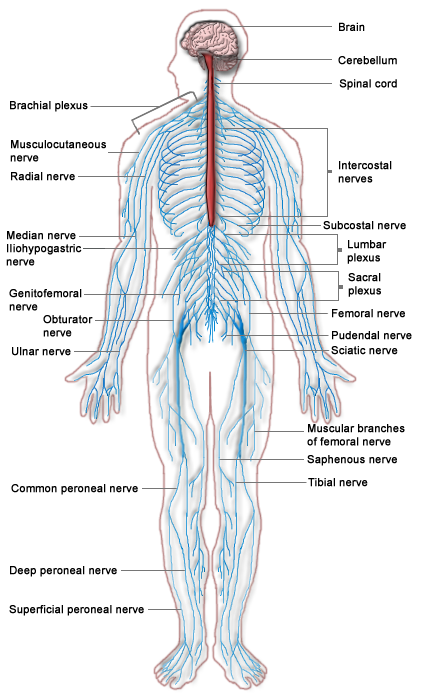10.1A: Organization of the Nervous System
- Page ID
- 7576
The nervous system is a network of cells called neurons that coordinate actions and transmit signals between different parts of the body.
- Describe the organization of the nervous system
Key Points
- Neurons (specialized cells of the nervous system ) send signals along thin fibers called axons and communicate with other cells by releasing chemicals called neurotransmitters at cell-cell junctions called synapses.
- Glial cells are non-neuronal cells that provide support and nutrition in the nervous system.
- In humans, the nervous system consists of both the central and peripheral nervous systems.
- The human central nervous system contains the brain, spinal cord, and retina.
- The peripheral nervous system consists of sensory neurons, clusters of neurons called ganglia, and nerves connecting them to each other and to the central nervous system.
Key Terms
- sensory receptor: A nerve ending that recognizes stimulus in the internal or external environment of an organism.
- peripheral nervous system: This system consists of the nerves and ganglia outside of the brain and spinal cord.
- glia: Non-neuronal cells that maintain homeostasis, form myelin, and provide support and protection for neurons in the brain and other parts of the nervous system.
EXAMPLES
A nervous system allows us to react to the changing environment around us.
The nervous system is an organ system that coordinates voluntary and involuntary actions and responses by transmitting signals between different parts of our bodies.
Neurons
Central to the functioning of the nervous system is an extensive network of specialized cells called neurons. Neurons feature many thin projecting fibers called axons, which penetrate deep into tissues. They are able to communicate with other cells by chemical or electrical means at synapses. Neuronal function is supported by neuroglia, specialized cells which provide nutrition, mechanical support, and protection.
Major elements in neuron-to-neuron communication: Electrical impulses travel along the axon of a neuron. When this signal reaches a synapse, it provokes release of neurotransmitter molecules, which bind to receptor molecules located in the the target cell.
Divisions of the Nervous System
In most animals, including humans, the nervous system consists of two parts: central and peripheral. The central nervous system (CNS) is composed of the brain, spinal cord, and cerebellum. The peripheral nervous system (PNS) consists of sensory neurons, motor neurons, and neurons that communicate either between subdivisions of the PNS or connect the PNS to the CNS

The Human Nervous System: The major organs and nerves of the human nervous system. The CNS is comprised of the brain, cerebellum and spinal cord. Remaining neurons, and associated cells, distributed throughout the body form the PNS.
The nervous system has three broad functions: sensory input, information processing, and motor output. In the PNS, sensory receptor neurons respond to physical stimuli in our environment, like touch or temperature, and send signals that inform the CNS of the state of the body and the external environment. This sensory information is then processed by the CNS, predominantly by the brain.
After information is processed, motor neurons return signals to the muscles and glands of the PNS, which responds with motor output. Central neurons, which in humans greatly outnumber the sensory and motor neurons, make all of their input and output connections with other neurons. The connections of these neurons form neural circuits that are responsible for our perceptions of the world and determine our behavior. Along with neurons, the nervous system relies on the function of other specialized cells called glial cells, or glia, that provide structural and metabolic support to the nervous system.

